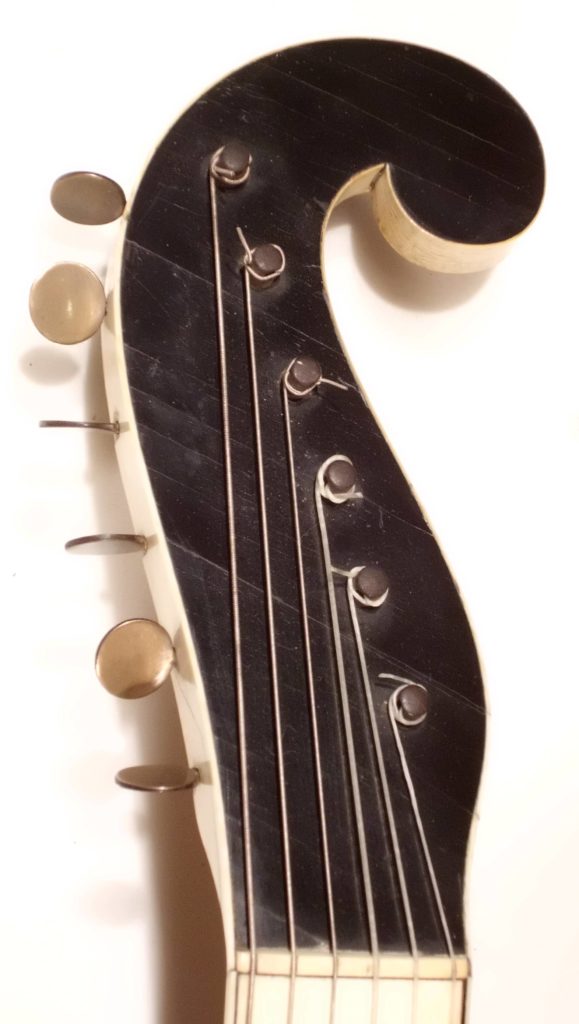C. F. Martin Sr. formed a business agreement with John B. Coupa in early 1840 that gave Coupa the sale agency for New York City. The Martin & Coupa label was only applied to guitars sold from the depot at 385 Broadway. An examination of about 50 Martin & Coupa period guitars shows that 50% have a Martin & Coupa label. The remaining 50% were sold directly by the Martin factory to their already established customers and thus did not receive the label.
This guitar is one of the very earliest Martin & Coupa guitars and is also the earliest known example with the fully mature Spanish shape, that Martin used for all their subsequent 12-fret guitars. Martin guitars made between 1834 and 1839 were shaped like the Stauffer guitars from Vienna, not surprising since that is where C. F. Martin Sr. learned his trade. By the time this guitar was made Martin had dropped the Stauffer shape and embraced the Spanish style of guitar. For a brief period between mid- 1839 and very early 1840 Martin made a transitional shape that was no longer Stauffer-shaped but was not quite Spanish shaped (two examples are known).
This guitar has several features usually only seen on pre-1840 Martins:
1) Shield-shaped bridge (introduced by Martin in 1836) with abalone and ivory “flower” or “ornament”
2) The sound hole decoration is a single ring on the inside of the sound hole
3) The spruce top is extremely fine grained (not encountered in later 19th guitars)
(The chapter on dendrochronology in “The Century that Shaped the Guitar” (Westbrook 2005) convincingly demonstrates the top wood of early Martin guitars is European spruce. The only conclusion that can be drawn is that C. F. Martin Sr. brought a supply of European spruce with him when he emigrated from Saxony. All pre-1840 Martin guitars have this type of top wood. This guitar is the sole example of a European spruce top that made it to 1840.) Since Martin made approximately 400 guitars between 1834 and early 1840 this must have been the extent of his original supply.
Martin & Coupa guitars were made for 10 years between 1840 and Coupa’s death in May 1850. Over that period Martin made many changes as he perfected his guitars and these changes can be used to help date Martin & Coupa period guitars, even in the absence of archival information.
The third photo below shows a couple of early features.
It can be seen throught the sound hole that there is a crescent-shaped piece of that forms the bottom of the neck block and extends to the rim of the guitar on either side. This feature is only seen on guitars circa 1840 to 1841, with only the earliest guitars having the piece of wood as thick as illustrated.
It can also be seen the guitar has solid lining which is the norm for most Martins from the period. Martin only started using individual kerfing blocks around 1843, although solid lining was used on small body and student model guitars throughout the remainder of the 19th century.
Although not illustrated the bracing is very unusual and is in the form of a two-strut fan brace.
There is only one “C. F. Martin New York” stamp on the guitar, on the back of the body near the neck heel.
Period features
Back and sides: Brazilian rosewood
Top: European spruce
Adjustable neck with elevated fingerboard – a common feature of fancier Martin guitars
Ivory fingerboard
Ivory binding
Ivory veneer on side of the headstock
Ebony headstock veneer
Brass Vienna mchines or, as Martin often called them, one side screws. This type of one side screw differs from the type encountered on earlier Martins.
Extensive use of fancy purfling on the top, sides and back of the guitar
Bridge pin mounted on the back of the guitar to anchor a strap or “ribbon”
Dimensions
Total length: 36-3/4” (933 mm) Fingerboard width at nut: 1.77” (45 mm)
Body length: 17-1/8” (435 mm) Fingerboard width at 12th fret: 2.17” (55 mm)
Upper bout: 8.54” (217 mm) Diameter of sound hole: 3.31” (84 mm)
Lower bout: 11.61” (295 mm) Scale length: 23.94″ (608 mm)
Depth at upper bout: 3.27” (83 mm) Depth at lower bout: 3.62” (92 mm)










